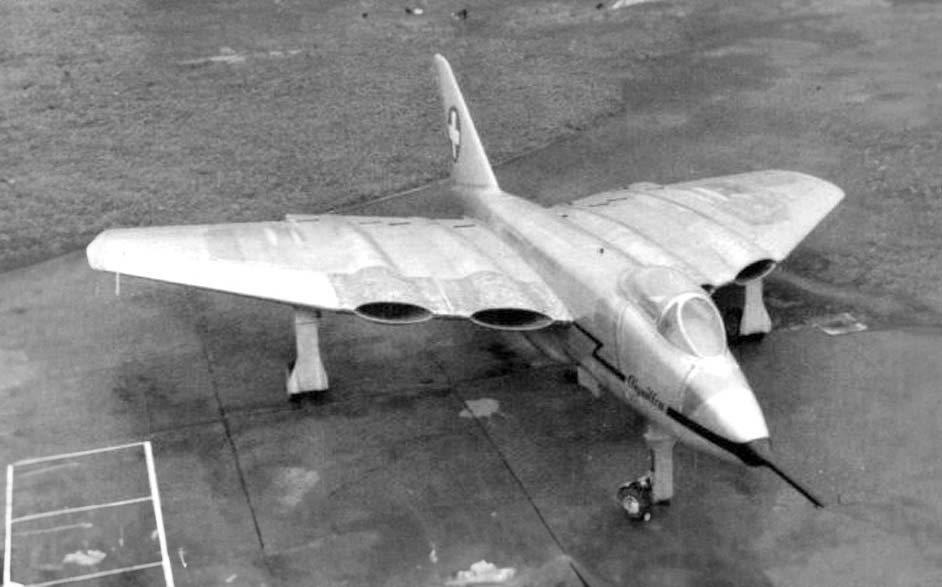The FAF EFW N-20 Arbalete was an innovative Swiss jet fighter with a unique pusher configuration and tailless design.
In brief
The FAF EFW N-20 Arbalete was a pioneering Swiss jet fighter developed in the mid-20th century. Known for its distinctive tailless design and pusher configuration, it represented a significant departure from conventional aircraft design. Although it never reached production, the N-20 Arbalete was a testament to Swiss innovation in aerospace engineering, aiming to provide a high-performance, versatile fighter jet. Despite its developmental challenges and eventual cancellation, the N-20 Arbalete remains a notable endeavor in the history of Swiss aviation, illustrating the potential and ambition of Swiss aircraft design and engineering.
The FAF EFW N-20 Arbalete was an ambitious project undertaken by the Swiss Federal Aircraft Factory (Eidgenoessische Flugzeugwerke) and Flug- und Fahrzeugwerke to develop a cutting-edge jet fighter. It reflects the period’s innovative spirit and the Swiss determination to create a competitive, domestically-produced aircraft.
History of the Development of the FAF EFW N-20 Arbalete (Crossbow)
During the mid-20th century, as jet technology revolutionized aviation, Switzerland embarked on a mission to develop its indigenous jet fighter to ensure national security and maintain technological independence. The N-20 Arbalete project emerged against the backdrop of the Cold War, where air superiority became increasingly critical.
Launched by the Swiss Federal Aircraft Factory and Flug- und Fahrzeugwerke, the development of the N-20 aimed to produce a versatile, high-performance fighter that could operate in the diverse and challenging Swiss landscape. Swiss neutrality and the strategic importance of air defense in a European context further underscored the project’s significance. The development process was marked by innovative design choices, including the tailless configuration and pusher engine layout, intended to enhance performance and maneuverability.
Despite the innovative design and potential, the N-20 never proceeded beyond the prototype stage. The exact first flight date remains undocumented due to the project’s cancellation before any prototypes became airworthy. The absence of a NATO nickname also characterizes its primarily domestic focus and the era’s limited international exposure of the project.
Design of the FAF EFW N-20 Arbalete (Crossbow)
The design of the N-20 Arbalete was revolutionary for its time, featuring a tailless configuration and a pusher engine design. The aircraft was planned to have a length of around 14 meters and a wingspan of approximately 11 meters. The pusher configuration, where the engines were located at the rear and “pushed” the aircraft forward, was chosen to allow unobstructed airflow over the wings and control surfaces, theoretically improving aerodynamic efficiency and maneuverability.
The aircraft’s design included advanced features such as swept wings for high-speed performance and a fully retractable tricycle landing gear. The use of lightweight materials and innovative construction techniques aimed to maximize the aircraft’s speed and agility while ensuring structural integrity.
Despite the innovative approach, the design presented several challenges, including complexity in engine maintenance due to the pusher configuration and potential issues with stability and control inherent to tailless designs. These factors, combined with the ambitious nature of the project and technological limitations of the time, contributed to the development difficulties.

Performance of the FAF EFW N-20 Arbalete (Crossbow)
The intended performance of the N-20 Arbalete aimed for superiority in speed, agility, and operational flexibility. While specific performance metrics such as top speed, service ceiling, and range remain speculative due to the project’s cancellation before full testing and development, the design parameters suggested a competitive aircraft with capabilities aligning with mid-20th-century fighter jets.
Analyses and comparisons with contemporaneous aircraft would likely have placed the N-20 in the higher echelons of performance, provided its advanced aerodynamic design and propulsion system delivered as intended. However, the lack of complete prototypes and subsequent testing means that such assessments remain largely theoretical.
Variants of the FAF EFW N-20 Arbalete (Crossbow)
As the N-20 Arbalete project did not progress to full-scale production or operational service, there were no officially designated variants of the aircraft. The project remained in the development phase, with continuous design iterations and refinements. Any planned variants or further developments were halted with the project’s cancellation.
Military use and combat of the FAF EFW N-20 Arbalete (Crossbow)
The N-20 Arbalete did not see military use or combat as it did not reach operational status. Its development was curtailed before any production models were built or participating in military exercises or conflicts. The project’s cancellation meant that the Swiss Air Force continued to rely on other aircraft for its defense needs.
While the N-20 never became part of Switzerland’s or any other nation’s armed forces, its development process and the technologies explored influenced Swiss aerospace engineering and contributed to subsequent projects and designs.
The FAF EFW N-20 Arbalete represents a fascinating chapter in aviation history, showcasing the ambition and innovative spirit of Swiss aircraft design during the mid-20th century. While it never reached the skies, the project’s bold approach to rethinking fighter jet design reflects a willingness to explore beyond conventional boundaries. The N-20 Arbalete remains a symbol of potential and innovation in Swiss aviation, contributing to the legacy of aircraft development and inspiring future generations of engineers and designers.
Back to the experimental aircraft section.